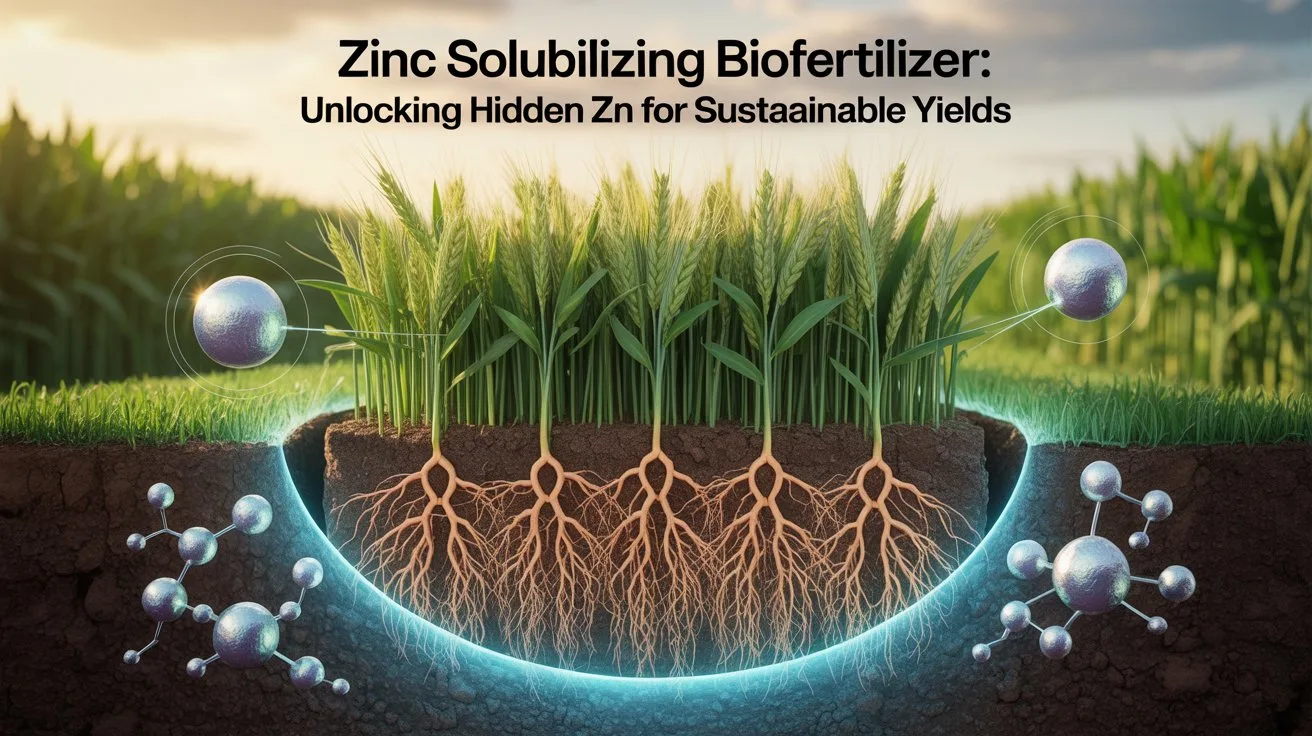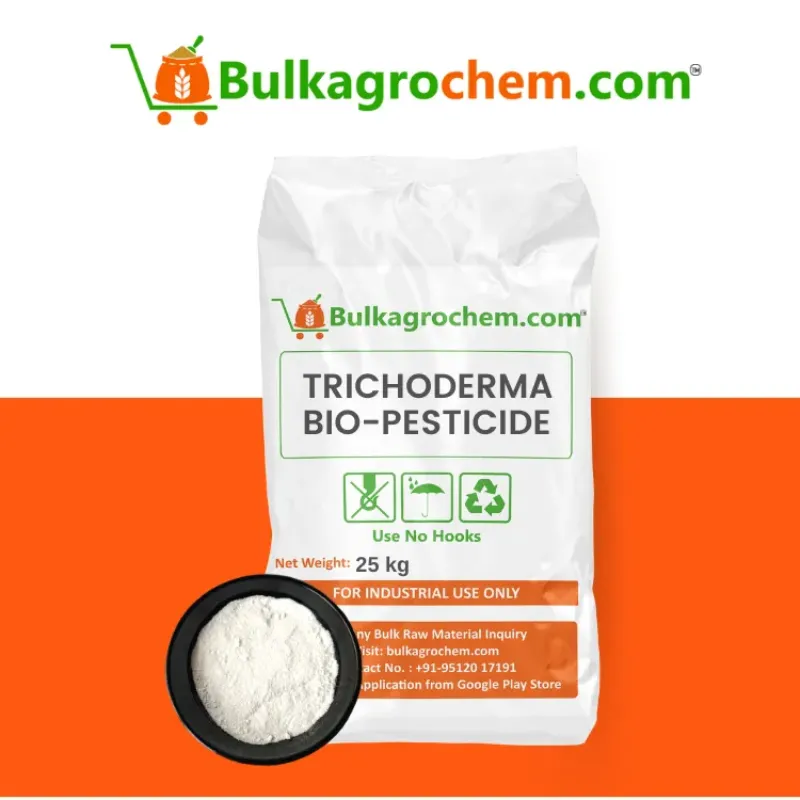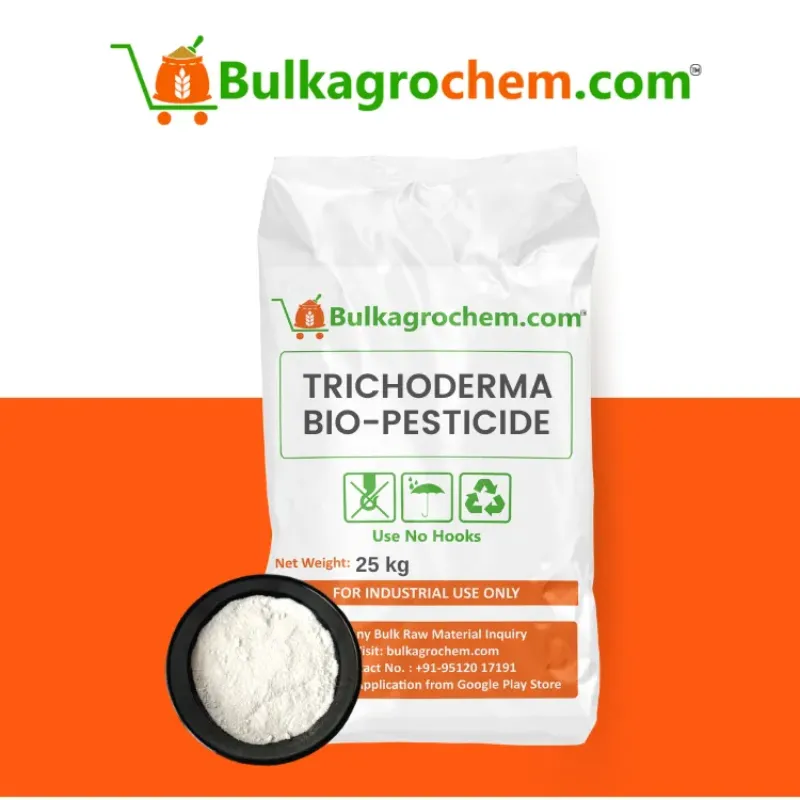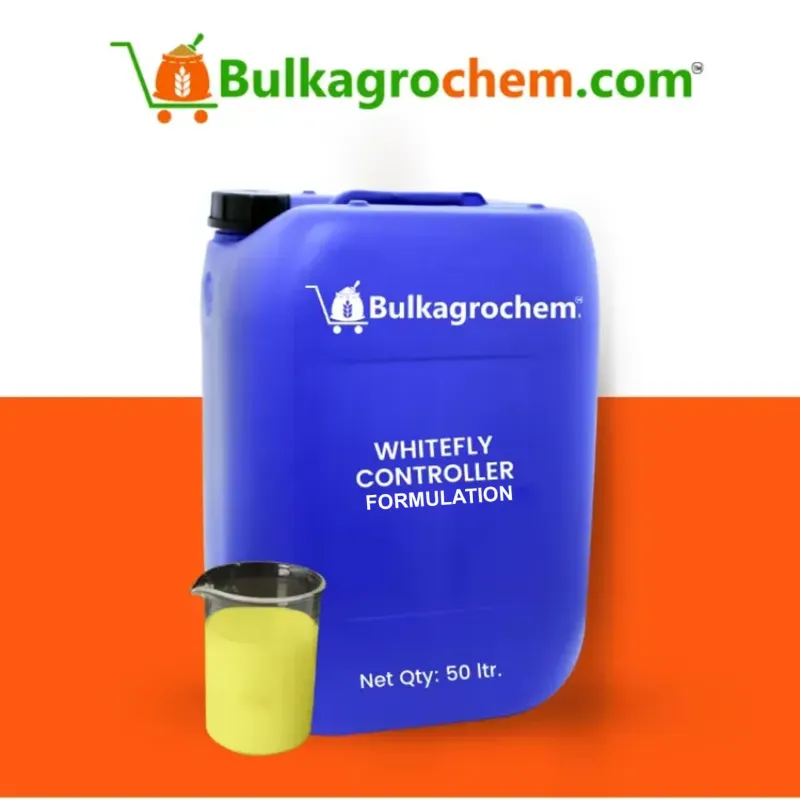A zinc solubilizing biofertilizer uses specially selected bacteria and fungi—most notably Bacillus, Pseudomonas and Penicillium strains—to convert the vast reserves of insoluble zinc locked in soil minerals into plant-available Zn²⁺ ions. Delivered as a shelf-stable liquid biofertilizer or coated onto seed, these microbes secrete organic acids and siderophores that chelate zinc, lower the micro-pH around root hairs and turbo-charge micronutrient uptake. Just 1–2 kg of inoculant per hectare can raise leaf-Zn levels within fQour weeks, boosting chlorophyll production, hormone synthesis and grain protein—often translating into 8-12 % yield gains on zinc-deficient soils.
Among the different types of biofertilizer—nitrogen fixers, phosphate solubilizers, potash mobilizers—zinc solubilizers fill a critical micronutrient gap while working synergistically with their macro-nutrient counterparts. When liquid Zn-solubilizing cultures are fertigated through drip lines or center-pivot systems, they colonize the rhizosphere uniformly, outperforming zinc sulphate by providing a season-long, low-salt supply and avoiding heavy-metal runoff. The result is healthier plants, fortified food quality and reduced dependence on mined zinc fertilizers—an essential step toward climate-smart, regenerative farming.
The Importance of Zinc in Plant Growth and Soil Health
Zinc (Zn) is the first micronutrient to limit yields on many intensively cropped soils. Even when nitrogen, phosphorus, and potassium are adequate, a shortage of available Zn can stunt root elongation, delay flowering, and slash grain protein. Because most native Zn is bound in silicates or carbonates, a zinc solubilizing biofertilizer offers a biologically elegant fix: living microbes release organic acids and siderophores that chelate Zn²⁺, making it root-ready without the salt load of zinc sulphate. When included in a multi-strain liquid biofertilizer alongside nitrogen-fixing and phosphate-solubilizing cultures (other different types of biofertilizer), growers obtain a balanced nutrient package that supports both yield and soil biology.
Hidden Zinc-Deficiency Symptoms in Major Crops
Applying a seed-coat or in-furrow zinc solubilizing biofertilizer can correct these hidden deficiencies before they progress to visible chlorosis and irreversible yield drag.
Critical Roles of Zn-Dependent Enzymes and Hormones
- Protein synthesis – Zn is a structural cofactor for RNA-polymerase; shortage means fewer enzymes and poorer growth.
- Auxin metabolism – Tryptophan synthase and other auxin-related enzymes require Zn, so deficiency leads to shortened internodes and smaller leaves.
- Antioxidant defence – Superoxide-dismutase (Cu/Zn-SOD) protects chloroplasts from oxidative stress, improving drought and heat tolerance.
- Pollen viability – Zn stabilises membrane integrity in reproductive tissues, directly influencing grain set.
A biologically supplied trickle of Zn from a liquid biofertilizer keeps these enzyme systems running at full speed throughout the season instead of a single chemical pulse that can be rapidly immobilised.
Global Extent of Zn-Deficient Soils
What Is a Zinc Solubilizing Biofertilizer and How Does It Work?
A zinc solubilizing biofertilizer is a formulation of live, soil-friendly microbes that transform insoluble zinc compounds—zinc oxide, carbonate, silicate—into plant-available Zn²⁺ right in the rhizosphere. Unlike zinc sulphate granules that can be re-fixed or leached, these microbes create a continual trickle of micronutrient at the root surface, synchronised with crop demand and gentle on soil biology.
Core Microbes (Bacillus, Pseudomonas, Penicillium)
Organic-Acid & Siderophore Mechanisms for Zn Release
- Organic-acid secretion – Gluconic, citric, and oxalic acids lower the micro-pH around mineral particles, dissolving zinc carbonates and silicates.
- Siderophore production – High-affinity chelators bind Fe³⁺ and Al³⁺, freeing Zn²⁺ that was co-precipitated with these metals.
- Enzymatic action – Phytases and other Zn-phosphatases hydrolyse organic complexes, unlocking Zn bound in crop residues or manures.
- Biofilm formation – Sticky exopolysaccharides keep the liberated Zn²⁺ in close proximity to root hairs, boosting uptake efficiency.
Advantages of Liquid Biofertilizer Cultures for Rapid Colonisation
- High cell density – ≥ 1 × 10⁹ CFU mL⁻¹ means an immediate microbial “critical mass” at seeding or via fertigation.
- Uniform distribution – Liquids coat seed evenly, infiltrate soil pores, and travel through drip or pivot systems without clogging.
- Quick revival – Cells in suspension re-activate within hours, speeding colonisation versus granules that may hydrate slowly.
- Easy co-formulation – Zinc solubilizers can be blended with nitrogen-fixing or phosphate-solubilizing strains (other different types of biofertilizer) into a single tank mix, giving plants a balanced nutrient boost in one pass.
By harnessing these mechanisms through a robust liquid biofertilizer, farmers convert latent soil zinc into an on-demand nutrient stream—fortifying grain protein, improving stress resilience, and reducing dependence on mined zinc inputs.
Positioning Zinc Solubilizers Among the Different Types of Biofertilizer
In a biologically driven fertility program, each microbe group tackles a specific nutrient bottleneck. A zinc solubilizing biofertilizer complements nitrogen-fixing, phosphate-solubilizing, and potash-mobilizing inoculants, forming a “balanced trio-plus-one” that delivers macro- and micro-nutrients simultaneously.
Nitrogen Fixers vs. Phosphate & Potash Solubilizers—A Balanced Trio
- N-fixers supply the engine for protein synthesis.
- P-solubilizers unlock ATP and root-energy currency.
- K-mobilizers regulate water balance and enzyme activation.
- Zinc solubilizing biofertilizer fine-tunes hormone production and antioxidant defence.
- Together they satisfy the 4Rs (right source, rate, time, place) through biology rather than salt additions.
Synergy with Mycorrhizae and PGPR Consortia
Mycorrhizal hyphae extend the root’s reach, shuttling the Zn²⁺ liberated by bacteria deeper into the profile, while PGPR strains produce IAA and siderophores that stimulate root branching and enhance Zn transporters. Field studies show grain Zn density rises 12 % when zinc solubilizers are co-inoculated with arbuscular mycorrhizae versus either input alone.
Designing Multi-Microbe Blends for Complete Nutrition
- Carrier choice: Use sterile peat or an all-in-one liquid biofertilizer to house N, P, K, and Zn microbes at ≥10⁸ CFU mL⁻¹ each.
- Compatibility screening: Test pH tolerance, antibiotic production, and carbon-source overlap to avoid antagonism among strains.
- Sequential release: Pair fast-acting Pseudomonas (early Zn supply) with spore-forming Bacillus (season-long persistence).
- Application strategy: Coat seed for early colonisation, then fertigate a liquid booster mid-season to maintain populations.
By positioning zinc solubilizers alongside other different types of biofertilizer in a single, easy-to-apply liquid biofertilizer, farmers achieve a nutritionally complete, low-salt, climate-smart fertility package that sustains yield, quality, and soil health year after year.
Field Application Methods for Zinc Solubilizing Biofertilizer
Deploying a zinc solubilizing biofertilizer effectively means getting viable microbes as close to emerging roots as possible—and keeping them fed. Below are three proven approaches that suit most cropping systems and combine smoothly with other different types of biofertilizer.
Seed Coating & Slurry Techniques for Cereals and Pulses
- Weigh seed and calculate inoculant amount.
- Mix sticker with inoculant; tumble until seeds are uniformly coated.
- Air-dry in shade (≤30 °C).
- Combine with N-fixers or P-solubilizers if using multi-strain liquid biofertilizer blends.
Soil Drench / Drip-Line Injection Using Stable Liquid Cultures
- Dilution: 1 L product in 100 L non-chlorinated water (pH 6–7).
- Drip fertigation: Inject 2–3 L ha⁻¹ every 15 days from V2 to flowering.
- Band drench (vegetables, orchards): 250 mL solution per plant base at transplant and again at first fruit set.
- Nozzle & filter: Use ≥80-mesh screens to avoid clogging; agitate tank continuously.
Why liquids shine: Suspended cells disperse through emitters, wetting the root zone uniformly. Gluconic and citric acids start dissolving Zn within hours, and siderophores chelate Fe/Al—double-freeing Zn²⁺ for uptake.
Integrating with Compost, Manure, and Minimal-Till Systems
Recipe for a bio-enriched compost windrow
Turn weekly; moisture 55 %. After four weeks, spread 2 t ha⁻¹ ahead of a shallow disk. In minimal-till, residue cover shades the soil, helping inoculant survival while mycorrhizal networks ferry the solubilized zinc deeper.
Stacking benefits: Compost supplies humic acids that feed bacteria, while low-disturbance tillage preserves fungal hyphae—together they magnify Zn release and improve structure and water retention.
FAQs
Q1. How fast will I see yield gains after applying a zinc biofertilizer?
Early root-zone colonisation means leaf-Zn rises within 3–4 weeks; most trials report 5–12 % yield gain in the first season when a quality liquid biofertilizer is seed-coated or fertigated.
Q2. Can zinc solubilizers fully replace zinc sulphate in severely deficient soils?
They can unlock 1–3 kg Zn ha⁻¹—enough to cut zinc sulphate 30–60 %. Extremely low-Zn fields may still need a small starter dose, then rely on the microbial supply thereafter.
Q3. Do these microbes work in saline or high-pH conditions?
Yes. Bacillus and Pseudomonas strains used in zinc solubilizing biofertilizer tolerate pH > 8 and moderate salinity, releasing organic acids that chelate Zn even in alkaline soils.
Q4. Is it safe to tank-mix a liquid Zn biofertilizer with fungicides?
Avoid copper-based or highly chlorinated sprays on the same day; most low-salt fungicides and micronutrients are compatible—always follow label guidance for all different types of biofertilizer blends.
Q5. How long will a liquid formulation stay viable in storage?
Sealed at 4–25 °C and < 65 % RH, a high-quality liquid biofertilizer maintains ≥ 10⁸ CFU mL⁻¹ for 9–12 months; refrigeration can extend shelf life even further.
Conclusion: Future-Proof Farming with Zinc Solubilizing Biofertilizer and Other Different Types of Biofertilizer
The evidence is clear: integrating a high-CFU zinc solubilizing biofertilizer into your program corrects hidden micronutrient hunger, fortifies grain quality, and lifts yields—without the salinity or heavy-metal baggage of synthetic zinc salts. When this inoculant arrives as a shelf-stable liquid biofertilizer, it dovetails effortlessly with drip lines, pivot systems, and seed-slurry rigs, delivering rapid rhizosphere colonisation and season-long Zn release.
Pair it with the full biological toolkit—nitrogen fixers, phosphate and potash solubilizers, mycorrhizae—and you unlock balanced, low-salt nutrition that rebuilds soil biology while trimming fertiliser bills 30–50 %. This multi-microbe strategy is the cornerstone of climate-smart, resilient agriculture: higher nutrient-use efficiency, lower greenhouse-gas footprint, and healthier food for a growing population. Adopt the suite of different types of biofertilizer today and future-proof your farm—yield, soil, and planet will all thank you.




